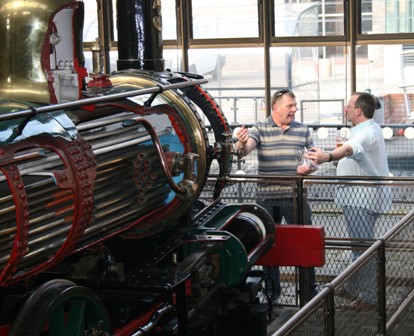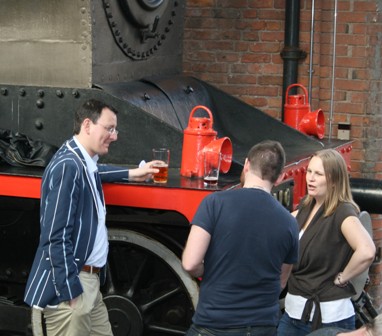
Driving debate: best bitter and impressive steam engines rub shoulders
Steamed up over ale: museum innovation on an industrial scale
When The Leisure Review heard of a beer festival with steam trains managing editor Mick Owen pulled rank and spent a happy afternoon at Manchester’s Museum of Science and Industry.

Driving debate: best bitter and impressive steam engines rub shoulders
As an exercise in challenging social stereotypes, hosting a real ale festival in a shed full of steam trains is probably not likely to succeed. Train spotters and “beardy weirdy” beer bores are both synonymous with the social isolation born of obsession and rank alongside computer nerds and carp fishermen as the people with whom one would least want to spend social time. The fact that Manchester’s Museum of Science and Industry (MOSI) – whose promise is “to provide the most authentic and inspiring experience of innovation in action” – managed to confound expectations and create a lively, friendly and hugely successful event with the addition of little more than a long bar on a raised walkway is testament to the unique atmosphere of their Power Hall and the changing face of real ale.
Working in partnership with the Trafford and Hulme branch of the Campaign for Real Ale (CAMRA), the museum offered some 50 cask beers plus ciders, a limited supply of perries and an array of foreign bottled beers over two evening sessions and a Saturday from 12 noon to 10.30pm. The slightly febrile atmosphere early on the last day was less a consequence of riotous binge drinkers seeking their next fix of alcohol and far more a build-up of anxiety among regular attendees at CAMRA events in Manchester, which have been running out of beer early in the proceedings, coupled with press reports for this event which spoke of long queues and high demand.
To some extent the organisers are victims of their own success as local branch publicity officer John O’Donnell explained: “On Friday night we were at capacity for over three hours and had a queue all the way round the block with visitors waiting up to 90 minutes on a one-in-one-out basis.” O’Donnell estimated that over 2,000 drinkers passed through the Power Hall over the three days and although that kind of pressure may be good for sales it brings with it the challenge of having enough stock. “Around 6500 pints of cask ale were sold, 600 pints of traditional cider and perry and 1000 bottles of German, Belgian and Dutch beer,” O’Donnell said. “The fact that the festival more than doubled its beer order for 2012 [this was the second year of the partnership] and still couldn't fully meet demand is testament to the fact that MOSI and the Power Hall in particular provides a very atmospheric venue for the festival. Although logistically it presents some challenges, we could not wish for a better setting in which to showcase some excellent real ales from the brewers of Manchester and Cumbria.”
The possibility of even these locally sourced beer stocks being insufficient was certainly one topic of conversation among the increasingly animated audience but so was the eclectic nature of that audience and the benefits of siting the event in something other than a marquee or a city-centre conference suite. While some drinkers used the various steam engines, which include a couple of trains, a beam engine used at Haydock Colliery and “the impressive 1907 McNaught engine from Firgrove Mill”, for resting their glasses on, many others took the opportunity to savour the heritage along with their ale. All over what used to be the transit shed of Liverpool Road Station, a terminus of the Liverpool and Manchester Railway whose value derived in part from its proximity to the Castlefield Canal Basin and so Northern England’s industrial interior, men, with or without beards and beer bellies, were gesticulating and indicating as they argued the toss about valves, spiggots and the like.
It is a testament to the design of the space that, despite heavy engines at every turn, the atmosphere is light, bright and relaxed. Huge windows let in light, colour and movement from other parts of the museum and the roof height creates airiness and whatever is the opposite of claustrophobia. This ambience transmitted to the visiting drinkers creating a feel to an event which may prove significant beyond Castlefields as the festival managed to do what CAMRA and others have been advocating in recent years by attracting a significant sprinkling of young people and women, some of whom were not white, to leaven the lump of middle-aged, middle Englishmen who might be expected to predominate.
The issue of women’s relationship to real ale is a live one with the latest edition of the CAMRA newspaper, winsomely called What’s Brewing, moving its coverage of the parliamentary row over a beer called Top Totty to its letters page, winsomely called Your Shout. For those who missed the furore, the beer was removed from one of many bars in the Houses of Parliament when shadow equalities minister Kate Green objected to the pump clip picture depicting a scantily clad woman in a servile role and the supposedly amusing name. The tenor of the latest letters was that of disappointment in CAMRA’s failure to condemn the brewery’s use of an outdated and sexist form of marketing. The future for real ale, and for CAMRA, rests in its ability to be as accessible to as many potential audiences as possible. Winsomely calling your beer Old Git, Old Slapper or even A Bitter T’ale – and all three were on offer at the MOSI event – is a shot in the foot for a product which is increasingly appealing to the young metropolitans flooding Manchester’s bars. Insulting women or the intelligence of any potential drinker seems at odds with the kind of forward thinking that put a beer festival in a context where radical thinking and innovation is celebrated.
With ‘sold out’ signs going up as early as 2pm on some beers at the MOSI festival and the event’s stock of perry gone before the Saturday crowd shuffled in there is little doubt that the combination of real ale and steam engines was a success. Where CAMRA takes the lesson is up to them but with the Cameron claque in parliament now starting to move against binge drinkers they might be advised to do so quite quickly.
Mick Owen is managing editor of The Leisure Review and a card-carrying member of CAMRA.
The Leisure Review, April 2012
© Copyright of all material on this site is retained by The Leisure Review or the individual contributors where stated. Contact The Leisure Review for details.
Download a pdf version of this article for printing
